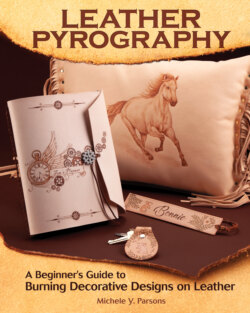Читать книгу Leather Pyrography - Michele Y. Parsons - Страница 7
ОглавлениеChapter 1
LEATHER
Leather Types and Terms
Leather is a material made from animal skins prepared for use by tanneries. Tanned leather is processed using several methods, such as with chemicals (chrome and dyes) or with natural, organic ingredients (bark and plants), also called vegetable tanning. When leather is burned, fumes are released into the air. Therefore, to avoid breathing chemicals, you do not want to burn on leather that has been chemically processed. Only burn on undyed, natural vegetable-tanned leather. Leather at the store or online is not always clearly labeled with the kind of tanning used to produce it. You can identify vegetable-tanned leather (also frequently called vegtanned leather) by its tan color and its classification as “tooling leather.” Vegetable-tanned leather is the type of leather that leathercrafters use for stamping, molding, and tooling. The most common and readily available vegetable-tanned leather in the United States is cowhide.
The smooth side of tanned leather is called the grain side. It is the side the hair was on when the animal was alive. The rough side of the processed leather is called the flesh side. It is the underside of the hide.
Leather Purchasing and Thickness
Leather is cut and marked in square feet (square meters) by the tannery to be sold as a whole hide or commonly cut parts of the hide:
• Whole: the entire animal skin or hide
• Side: half of the entire animal skin or hide from the neck to the tail
• Double Shoulder: the shoulder area from a Whole
• Single Shoulder: the shoulder area from a Side
• Back: the portion of a Side with the Belly removed
• Belly: the portion of a Side with the Back removed
Leather is priced by the quality of the grain (smooth) side. If there are a lot of blemishes, such as cuts or branding marks, the hide is sold as Economy leather. If there are only a few blemishes, the hide is sold as Good Quality leather. Finally, if the hide is blemish free, it is classified as Excellent Quality leather.
Leather is also priced by the weight of a square foot (square meter) of the hide. When leather is processed, it is split so that its thickness becomes more even. Due to natural variation in thickness even after splitting the hide, leather is marked and sold using a weight range, such as 6 to 7 oz. Due to the weight being determined by the thickness of the leather, there are common usages of leather in certain weight ranges (see table on page 10). Leather of any thickness can be used for pyrography. However, care must be taken on the thinnest leathers with the skew pen tips. The skew is like a knife and, when hot, can slice right through the leather if pressure is applied.
A simple gauge can help in readily identifying the thickness of leather.
| Thickness | Thickness in Ounces | Thickness in Inches | Thickness in Millimeters | Characteristics | Common Uses |
| 2 to 3 oz | 1/32" to 3/64" | 0.8mm to 1.2mm | very thin and pliable | Used for molding, embossing, quilting, appliqués, linings, and jewelry | |
| 3 to 4 oz | 3/64" to 1/16" | 1.2mm to 1.6mm | thin and pliable | Used for molding, embossing, repoussé, appliqués, linings, thin clutches, thin wallets, and billfolds | |
| 4 to 5 oz | 1/16" to 5/64" | 1.6mm to 2.0mm | thin and pliable | Used for molded leather masks, appliqués, clutches, wallets, billfolds, wristbands, and conceal carry holsters | |
| 5 to 6 oz | 5/64" to 3/32" | 2.0mm to 2.4mm | sturdy and pliable | Used for die stamping, small cases, and notebook and journal covers | |
| 6 to 7 oz | 3/32" to 7/64" | 2.4mm to 2.8mm | sturdy and flexible | Used for die stamping, handbags, medium cases, journal covers, and straps | |
| 7 to 8 oz | 7/64" to 1/8" | 2.8mm to 3.2mm | sturdy | Used for die stamping, knife sheaths, narrow belts, straps, handles, and small holsters | |
| 8 to 9 oz | 1/8" to 9/64" | 3.2mm to 3.6mm | very sturdy | Used for die stamping, belts, holsters, and saddle bags | |
| 9 to 10 oz | 9/64" to 5/32" | 3.6mm to 4.0mm | extremely sturdy | Used for die stamping, belts wider than 1 ½" (3.8cm), and larger holsters |
